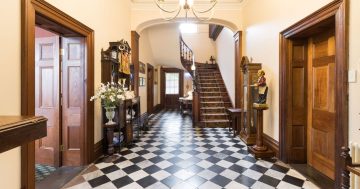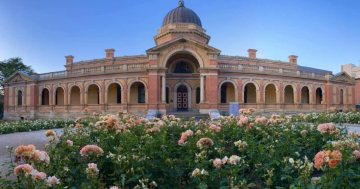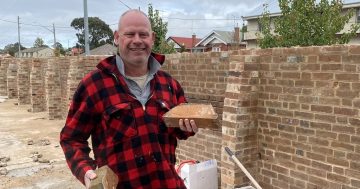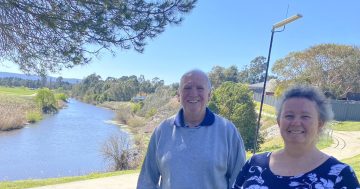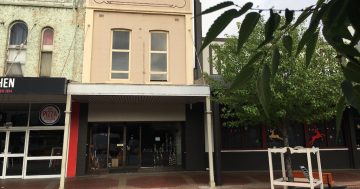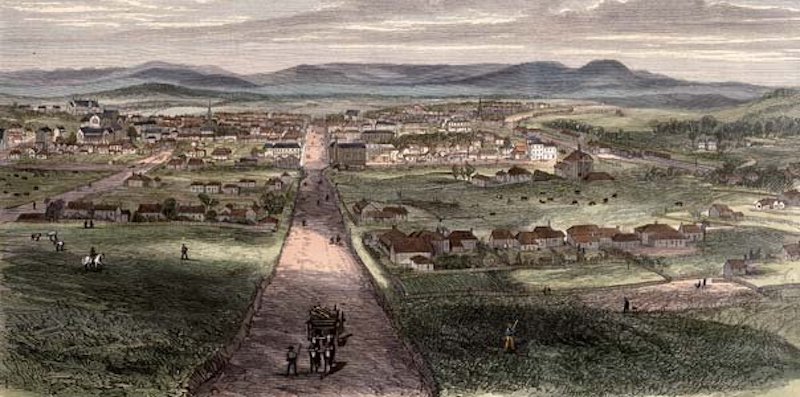
A closer study of this picture will enable Goulburn people to locate Clinton Street, a slight bridge over the creek running parallel to the street and two mills, including one on the right where Kennards Hire is today. Further along the left, on the corner of Clinton and Bourke streets, stands the Sisters of Mercy Convent, but the chapel is yet to be built. Photo: Steve Ayling.
Looking at the early picture above of Goulburn, Steve Ayling asks himself why the main road today swerves to the right on the northern and southern exists from the central business district.
The Goulburn sketch artist puts on his detective’s hat and also asks why one of the cathedrals stands higher than the other. From the railway and presence of prominent buildings and absence of others, he deduces the picture was probably drawn about the 1870s or 1880s, leading to another question:
Where is the pall of smoke hanging over the town from the iron foundries, mills and people cooking? After all, Steve has seen while studying the stories architecture keeps, pictures of this era and remembering heavy smoke was part of the landscape.
He writes to the NSW Art Gallery Library to say the previous owners of his and wife Claire’s residence, Mandelson’s of Goulburn, had obtained the original coloured lithographic print in Sydney.
“We think it relates to a funding push by Bishop Mesac Thomas to build the Anglican Cathedral which was approved in 1863 when Goulburn was declared the first inland city [because of the cathedral],” he said.
The library replies, revealing the original was a wood engraving by artist Albert Charles Cook. The Australasian Sketcher with Pen and Pencil published it on 27 March, 1880. The monthly magazine employed many prominent artists, who provided an important pictorial account of life in the colonies before the widespread use of photography.
The picture became a lithographic print, and today is enlarged within a 2-metre x 1-metre frame hanging in Mandelson’s, enabling the viewer to see a swollen Wollondilly River and a lagoon reaching the edges of where Bradley Street intersects with Auburn Street. That lagoon explains why the road north veers right along Lagoon Street, named after the water that once pooled there, perhaps ensuring the road wasn’t cut during flooding.
The main road’s other right-hand turn heading south avoids the steep pinch up Auburn Street, which would have been almost insurmountable for ox and cart back in the day.
For Steve, one of the picture’s most revealing aspects is the Anglican Cathedral. He says Bishop Mesac Thomas, the first appointed bishop for the new dioceses for Goulburn, which covered a huge area, wasn’t in Goulburn from England for a retirement posting. Bishop Thomas stayed at Mandelson’s, from where he set about raising money for the cathedral and had his residence Bishopthorpe built.
“My view is that this picture was part of Anglican marketing in addition to other purposes, maybe aiming for the English and other protestants to say this is a fine Anglican, protestant town,” he said.
“It is a stylised view of the future cathedral, shown up high on a ridge line and readily seen by all in Goulburn by looking to the west and seeing this glorious building on the rise.”
Still under construction at the time, the Catholic church was becoming a cathedral and is shown in the shadows.
This picture and ones like it promoted regional towns as good ideas for investment and immigration from England.
“It portrays them as thriving, peaceful, secure, pleasant, well-established places with plenty of water and greenery to entice people to come and choose this place,” says Steve, a keen historian.
Towns were competing against one another, and even within Goulburn there was rivalry.
“It may be that’s why, in my opinion, there is deliberate lightening up of some areas in the town, and money may have changed hands to achieve that, but I think that was part of the bigger picture,” Steve says.
”It wasn’t just a passing snapshot of Goulburn to put in someone’s travel journal.
“At the time, cities throughout England and Europe were hellishly overcrowded and polluted, and life was very hard. About that time, wars were going on willy-nilly. The unification of Germany only happened in the 1860s; same thing in Italy.”
This picture was to say leave all that behind for a fresh opportunity for people and their children to grow up in utopia. The absence of smoke and ladies wandering the main street underline that idyllic notion.






